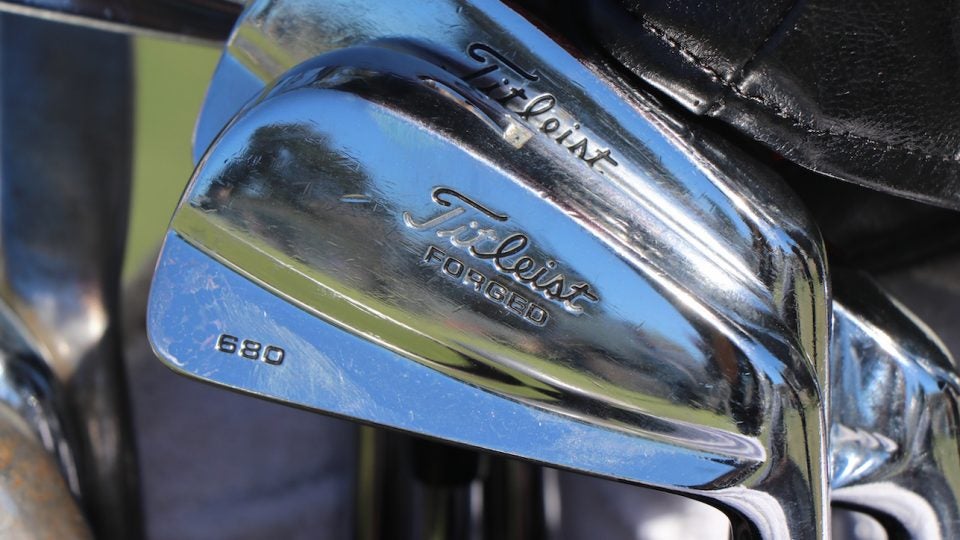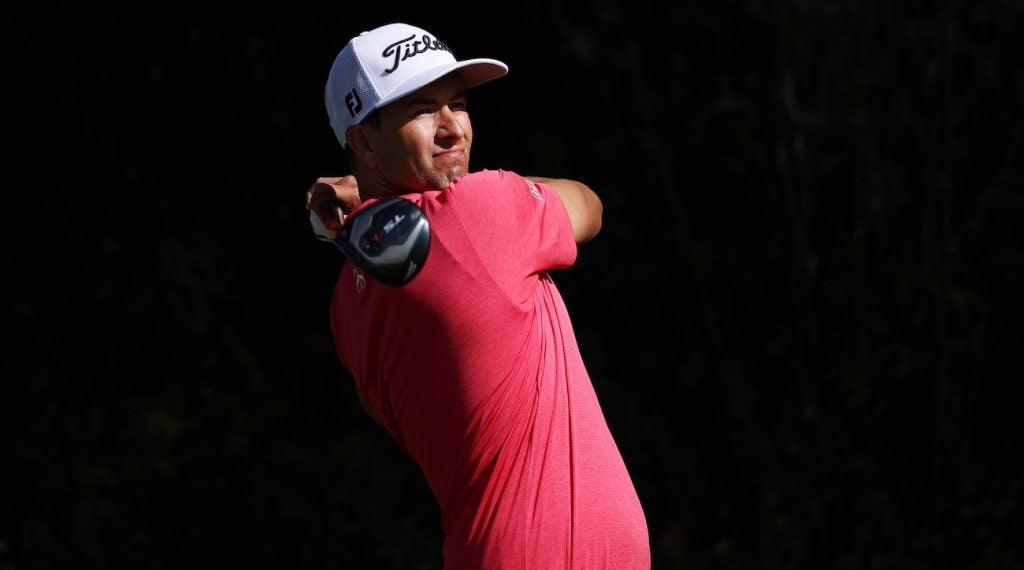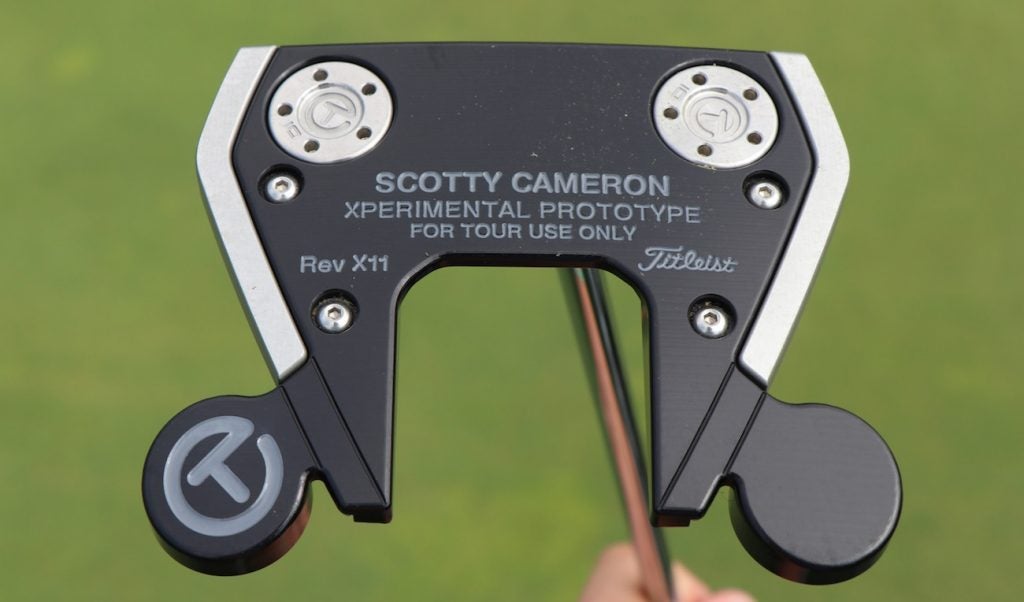 CJ Cup Byron Nelson Subpar picks: 2 players to watch in Texas
CJ Cup Byron Nelson Subpar picks: 2 players to watch in Texas
Gear Talk: Adam Scott speaks on his Titleist irons from 2003, unique putter testing philosophy

Following Adam Scott’s win at The 2020 Genesis Invitational, GOLF.com caught up with the 14-time PGA Tour winner and 2013 Masters Champion to speak on all things equipment.
In the full Q&A below — with questions from multiple media outlets — Scott covers his recent driver shaft change, why he loves his old Titleist 680 blade irons, the reason behind why he tests so many putters he doesn’t plan on playing, and so much more.
Question: We got a little information from Titleist about the shaft change that you went with at Riviera. Part of what JJ VanWezenbeeck was saying was that you lost a little bit of head feel with the new driver. I was just wondering if you could expand a little bit on what that meant, and what it is about the TS4 that appeals to you?
Adam Scott: Right. Without getting too much into the background of it all, the equipment has come a long way since when I turned pro. I’ve been playing Titleist my entire career, which is incredible. This is my 20th year with them. The DNA of my golf swing has had to adapt as the changes have been made. The difference in what we’re playing now to when I turned pro is a lot. I had a 137-gram shaft in a very small Titleist 975d head at 43.5 inches, and now we’re at 45 inches and 460cc heads with a shaft that weighs nearly half as much as what I used originally. So there’s a lot of adapting, although it’s been gradual.

I’ve always liked feeling where the clubface is, and as heads get bigger and center of gravity goes rearward, you lose that face awareness even though you gain face stability. So finding that balance point for me got me into the TS4 last year, which is a slightly smaller head and I felt like that I could feel the head a little more than the TS3. And I pretty much used the Kuro Kage shaft or the Graphite Design AD-DI 8 shaft since 2010; they’re my two go-to shafts that I like. I just felt like as we increased the head weight last week to feel the head even more, just having that slightly more stout tip in the Kuro Kage might balance out the extra head weight and the load that’s going to put on the end of the shaft. And it married up pretty nicely. I was quite happy with the change. Obviously, the result was incredible. I felt like all the speed was at impact, I wasn’t losing any speed, and the strike was much more out of the middle of the face. It felt far more efficient for me swinging the club.
Q: You’re still using the Titleist 680 blade irons after a number of years. When exactly did you start using those irons and what is it about them that you love so much?
Scott: Well I used them I guess when they came out, in about 2003. I had some 681 irons, too, back then. Then I moved into AP2 irons for a while when they first came out, then I used the MB 710 blades – I actually won the Masters with the 710 blades. But as the MB irons progressed, they got a little further away from where my comfort level was, which is more in that 680 range. After the 710s, I fell back into the 680s. I guess I like offset, and they have a little more offset, a longer blade, a higher toe, they’re less boxy and less symmetrical.
The irons are made so beautifully and perfect now, but it’s just a little different than what I grew up looking at. There’s very little offset; not many guys out here play with offset these days, but that’s what I grew up playing and that’s what the 680s have. Also, they have quite a sharp leading edge and sole, and that kind of turf interaction is a big thing for me. It’s quite a sharp edge and it keeps me very shallow, and I know if I’m getting steep the club is going to stick in the ground a little bit so it helps me keep my swing where I like it.
Q: I heard from Aaron Dill a few years ago that he was coming up with a three-wedge system and four-wedge system for you, and you were going to be making wholesale swaps in the wedge section of your bag based on what you were doing at the top end from course-to-course. Can you explain a little bit of that process?
Scott: I pretty much stick with the four wedges now, which are 48, 52, 56 and 60 degrees, and I am using the SM8 wedges. That system was really based on having a bit closer look at the statistics and how golf courses are playing. When there were over a certain amount of wedges into greens, it was better to have four wedges, and have the gapping a little easier to manage than three wedges. I saw that at TPC Sawgrass was a big one I was at a disadvantage with three wedges because I was hitting a lot of half wedges instead of having a full, perfect number all the time. Really, the only time I move away from the four wedges now is at a links golf course; certainly The Open every year. When you get to The Open, loft kind of becomes your enemy and you want to keep that ball on the ground a little more, so the three wedges work there. Then an extra iron goes in at the top end. But pretty much, on the PGA Tour, the four-wedge system works for me.
Q: Speaking to the wedges, you’ve switched into a full setup of SM8s, and there’s a lot more technology in terms of center of gravity. Have you noticed a big difference in control of your ball flight, and how does that help in terms of the course conditions you faced at Riviera, as well as at the Presidents Cup?
Scott: I think Titleist did some really nice work in terms of moving that weight around again in the SM8, listening to a lot of feedback, and cleaning up a few things with where the weight was. I actually think the profile of the SM8s is slightly larger than the last ones, but that might just be to my eyes. They look very good to me. Interestingly, I was usually use an 8-degree bounce in my lob wedge, but in the SM8 I feel like the sole on the K-grind, which I’ve always used, is even wider. So I’ve gone down to a 6-degree bounce. The really, really wide sole is an extra bit of relief, making up for those couple degrees of bounce. It was interesting because I first played them in Australia and it was very firm, but that K-grind gives me versatility off the firm, hard ground. It’s also good when going into a bunker with that wide sole to get some relief. They are very versatile.
Then bringing the wedges to Riviera, which was also firm but a very different kind of grass – you know, the Kikuyu style grass – the wedges worked incredibly well there. For me, I’m looking for that versatility in all my clubs so they’re just not one-trick ponies. I’d rather leave my bag the same all the time than bring wedges in and out depending on conditions. There’s so much feel involved with a wedge, you want it to be your trusty club. And having that versatility is an important thing for me. So I’m very pleased with where Titleist has gone with the new wedges and it’s been a really nice change over for me with great results.
Q: As you mentioned earlier, you’ve been with Titleist for a very long time, and certainly you were playing professional golf in the early days with a Pro V1 and continued on. What have you seen in terms of the evolution of the Pro V1 over that time?
Scott: Well, going back to the start, the Pro V1 was really quite revolutionary for the golf ball. Remembering when it came out, how much of an advantage it was to be playing the Pro V1 versus anything else at the time was quite openly talked about, to be honest. There was no doubt it was going much longer, but still provided the control. It was just a far superior golf ball. It has evolved a lot in 20 years. I think the introduction of the Pro V1x ball was another big step. All the sudden, an even-better performing golf ball as far as length when it was first introduced – the X was more of the length and the V1 was the feel, with length as well. Titleist really nailed it with a V1 and an X, and it’s been known that way ever since in the golf industry. Other manufacturers have followed, even in naming the golf ball that way. Really it is quite a revolutionary golf ball, and, luckily for me in my 20-year career, I’ve never had to have to worry that I’m not playing the best golf ball on the Tour.
Q: You do a lot of putter testing week-to-week — sometimes with short putters, sometimes with a number of different long putters. How do you ultimately decide which one to use that given week? Also, how did the Scotty Xperimental prototype putter that you used to win at Riviera end up in your bag in the first place?
Scott: Sometimes I like practicing not with the putter that I’m going to use. I mean, I know I’m going to use it, but I just don’t practice with it because then I put it back in and it feels fresh and new and it’s just kind of the mind games that I have to play with myself to get the best performance out of me. But it does feel like that sometimes. I like putting around with a short putter, and I think I’m getting good with it and then I pick up the long one again and I realize that I’m much better with it. That’s kind of the reassurance I need to just go out and perform with a longer putter. But, there’s some different theories and tests that I do, and I’m always looking for the best putter, that’s for sure.
ADVERTISEMENT

I’ve worked fairly closely with Scotty Cameron and Paul Vizanko and his team for the last 7 or 8 years, since I’ve went into the long putter. Certainly that was a challenge for them at the start because they weren’t producing many long putters, but this has evolved and it also helped them make some designs for their regular line, as well. But the Xperimental 11 was a putter that I never used until after the anchoring ban when I cut it down shorter. I found it performed very well non-anchored. Really, at the moment, at the back of last year’s performance on the greens and where things are at the moment, it’s the best when I do my little experiments and tests. I certainly have my feeling with it, as well. That putter was developed after winning The Masters and getting to No.1, and kind of refining the Futura-style putter that I was using at that point.
Q: Piggybacking off that question, you brought out a Scotty Cameron Kombi broomstick for the first time at the Accenture Match Play Championship in 2011. Can you explain what got you to try that to begin with and where you got one?
Scott: So in 2010 I played very well and I won two tournaments that year and I was putting with a conventional-style putter. But, my frustration levels were just too high. I was either putting really well or really terribly. There was nothing ever in-between and I wasn’t sure what was going to show up any given week. It was 10 years into my career, and at that point, I think underperforming at the biggest tournaments led to those high levels of frustration. Actually, my coach Brad Malone had gone and bought a broomstick from a golf shop in Australia. He was putting in my backyard with it on the green. I went out and saw him and asked him what he’s doing.
He said, “I’m just testing stuff.”
Of course, he knew that curiosity would get the better of me and I asked to hit a few putts with it. So that’s how that came about. To be honest, I got the hang of it pretty quickly and kept working with it. Then we said, “We need to give this thing a shot because it performs well on the putting green. So let’s see.” Of course, I knew there would be a few interesting looks at the Match Play when I came out putting with a broomstick — to say the least – but, to be honest, I didn’t really care. I was more interested in achieving some results. I don’t think I won the match that day, and then I struggled the next week at Honda – that wasn’t necessarily the broomstick’s fault. But then I finished 3rd at Doral and then 2nd at The Masters, and I made some good putts with it. That’s when it was really taking off. I believe after I finished 2nd at The Masters I had like 20 broomstick putters ordered that Monday to Hilton Head.
Q: You mentioned tweaking your driver and tweaking your setup a little bit for links golf. This week in Mexico, playing at a lot of elevation, are there any equipment changes you’re making to account for the longer-flying golf ball and thinner air?
Scott: No. Really the best way to tackle this is to get on the range and find out how far you hit everything. Get some new numbers to work with this week. It makes it a little harder on the golf course, because I’m probably not going to be able to memorize my new numbers. The best thing you can do is find out exactly how far you’re hitting it with this extreme altitude here, and then do the best you can out on the golf course. The trickiest thing is like your 5-iron might go 240 yards here. But if you knock it down or you hit it a little softer and the ball just doesn’t get up in the air as a full shot would, it might go 25-30 yards shorter, which is a much bigger difference than if you were playing at sea level. If you hit a softer 5 iron it might only go 10 yards shorter at sea level. It’s going to be a week where you want to play your full yardages more often than not, if you can.
Q: Obviously every week on the PGA Tour there are a million vans and Tour reps, and the equipment scene is pretty busy. When you’re playing in Australia, can you give us a sense of what it’s like compared to what it’s like on the PGA Tour?
Scott: It’s very different than that (laughs). I think without being biased, Titleist covers the Tour in Australia better than anybody as far as representation goes. The biggest challenge is always having the equipment to be able to make any adjustments at the golf course. We don’t have the vans in Australia like we do in the states and in Europe and in Asia. We have vans, but they’re much less for what the golf club has to offer. So you need to be a little bit more prepared, if you’re looking to make a change. You need to have that in advance and be ready to go with what you’ve got. But I think, generally, that’s what I try to do out here (on the PGA Tour). JJ (Van Wezenbeeck) and his team on the Tour for Titleist, for me, they’re there as backup, like if something really went wrong that we weren’t thinking about. I try to do all my changing and testing away from the Tour. I want to be ready to play when I’m out here, and I know they have my back if a club breaks or if there’s something unforeseen. But I like doing my testing in another environment and being prepared to play when I’m here.
To hear more gear insights from Jonathan Wall and True Spec’s Tim Briand, subscribe and listen each week to GOLF’s Fully Equipped podcast: iTunes | SoundCloud | Spotify | Stitcher
ADVERTISEMENT





